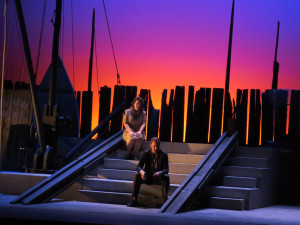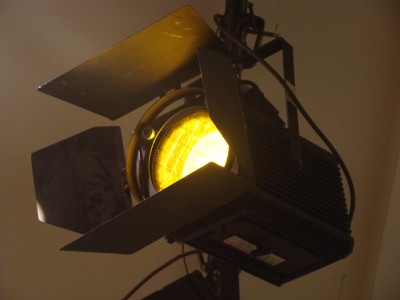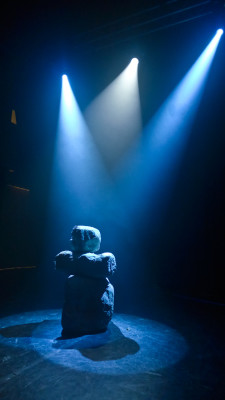What personal skills are needed to become a lighting designer?
Like all jobs in theatre there is no single route: designers and technicians learn by various mixes of formal and informal methods. It is possible to design professionally for theatre without any formal training in theatre design or art by just relying on talent or observation. But even the most talented persons can usually benefit from a situation structured to encourage personal development through discovery.
I would suggest the following personal qualities seem desirable:
• Strong visual imagination
• Ability to express and communicate this through various media, especially drawing.
• Wide interest in people, their relationships with each other and with their environment, both in reality and as reflected in all the arts, today and throughout history.
• Commitment to theatre
• Personal ability to relate to and work with the other members of the creative and interpretative team that constitutes a theatre.
REID, Francis. Designing for the theatre. London: Black, 1989. ISBN 07-136-3136-8.
An interactive E-learning course that is available at this web site is aimed to promote knowledge of lighting design not only to the interested students, but to general public as well. Naturally as being a craft that requires a practice and direct experience, lighting design cannot be taught without face to face contact, however, a large part of knowledge that is a prerequisite for understanding a variety of issues and their solutions is of a theoretical nature and can be transmitted by words and pictures. Such knowledge ahead of actual work with light might be a considerable advantage, leading to better understanding, improved cooperation with other co-workers, enhanced ability to imagine possible outcomes of the work, raised probability of being able to further self-education.
Nonetheless, the outcomes of the work with light are many times beautiful and thus the general public that seeks to satisfy its need for beauty may find its source at this pages. Similarly, it can educate itself and be incited to search for connections that creates a link between culture, science and art.
There are six courses available, each of which deals with one point of view to lighting design as a field, which is conditioned by laws of nature, culture, technology, bureaucracy, politics and artistic vision alike. Each course is based on fixed structure that offers first an introduction to the specific theme, followed by a test that determines the level of knowledge, key terms that are indispensable for thinking the specific issue, the body of the lesson itself that conceptualize the theme, follow by task to be made by the reader, case studies that demonstrate the principles and fact in the lesson on the individual situations, sources and literature that are connected to the issue and may be a point of departure for further study, closing test determining how much has been understood by the reader and a possibility of contacting the tutor of each lesson.
Do you think that it is possible to study lighting design and is it needed?
This is a controversial question. Learning is always useful. On the other hand, one cannot expect to learn everything at school … I think the importance of the school is that it creates space for discussion. I often miss some kind of a feedback from the outside. In many countries, there are no critics who are able to critically evaluate a lighting design. It induces an emotion in them but they can’t describe what kind of and how. A school has something to offer in this particular regard. It will give the people the opportunity to criticize, discuss and articulate their differing opinions. Also experimenting is quite difficult in the given professional conditions. Once someone is working on a performance, which has limited time and the thing must be done, he doesn’t have the opportunity to try a variety of lights, colors and their combinations. The school is also very useful for tests with different technologies and ways to handle it. I also did workshops with small children and it was absolutely amazing how inventive they were while using the light.
Sergio Pessanha
What is the main purpose of the knowledge center? It was designed to offer knowledge to anybody interested in this issue. After this course is taken, the disciple should be able to to design and implement a lighting design for a short performance with the help of basic sources of light (conventional, LED).
To be familiar with the properties of light and its perception. Intensity, angle, color, beam, distribution within the space (detail / whole), movement (timing, change), perception and impact (relativity of perception, cold – warm, soft- hard, connotations of colors)
- The role of lighting in a performance: : selective visibility, composition, mood, revelation of form, information
- Concept, planning of the lighting, visual, show
- Implementation and replication of lighting in specific space (hanging, focus, programming, safety), and how to implement the same look the next time in other spaces when touring (documentation)
- Communication “strategy”: with whom and why to communicate
Content of individual lessons
1/ Perceiving the Light
tutor: Isabel Nielen, Jan Purkert
This lesson deals with the issue of perceiving light. Our way of seeing is to a large extent determined by factors, which we are often not fully aware of. This lesson is generally about perception of light in the cultural, social, philosophical and historical context.
In detail, it concerns the role of light in history. (Generally) Natural vs. artificial light. Development of lighting. Evolution of theater (space, technology, lighting).
Perception of light by the sight, optical illusions. Color contrast and the difference between cold and warm light. Adaptability of the spectator’s eye (“ White”, intensity of light). Attribution of the meaning to the light, metaphor (psychology of colors). (Theater) Lighting design. (Theater / Stage lighting)
The purpose is to trigger more awareness about the context of lighting and lighting conditions, aesthetic and function of lighting, origin and reason for lighting.
2/ Understanding the Light
tutor: Ondřej Růžička
This lesson deals with the issue as much as the nature concerns. In detail, it treats the physical qualities of light (reflection, refraction, scattering). Color temperature. Theory of colors, color mixing. The problem of “white”. CRI.
Reproduction of colors, their mixing RGB and CMY with instruments, effect on the stage / object.
The goal is to understand the basic qualities of light, the effect they produce on various surfaces of various qualities, to learn how to think over and intentionally work with reflection, refraction, color.
3/ Shaping the Light
tutor: Šimon Kočí
This lesson deals with the issue as much as the technology concerns.
The system of stage lighting, its connection, DMX protocol. (Dimmers, channels, circuits, lighting console)
Basic types of instruments and sources of light, their characteristics, advantages and disadvantages and typical use. Typology according to the beam and use. (Floodlight, Par, PC, Fresnel, profile, low voltage, fluorescent, simple bulb, follow spot, pinspot, LED RGB, moving head, strobe, laser, video projector). Instruments accessories. (Barndoors, Iris, Gobo, filters, scroller, tripod, floorstand, tower)
The goal is to present the basic units for theater use and to understand the differences between them, their characteristics and quality of produced light, in relation to the type of a source of light. The difference between stage lights and lights for other uses (permanent installations – architecture, interior).
4/ Directing the Light
tutor: František Fabián and Martin Špetlík
This lesson deals with issue’s of placing lights and using different angles.
Positions of instruments and its angle in the relation to the stage / object, basic directions of light and their combination, distance and its connection to the beam of light. (Beam, throw, angle, focus, set up etc. ) Drama vs. Dance.
Key light, fill light, actor´s light. Three point lighting, Four point lighting, combination of directions, angles, positions of instruments .
Division of the space, stage elements ( backdrop, projection screen, legs, borders etc.). Hanging points, positions for placement of headlights ( bridges, ramps, proscenium, balconies, boxes, grid, truss system, fly bars).
The goal is to understand the influence of angle, direction, position of a source on the scene, attraction of attention of a spectator to the object or actor, creation and formation of the space. Possibilities of creation of a semantic context, shift.
5/ Inventing the light
tutor: Henk van der Geest
This lesson deals with light design in artistically and practical context.
Ambiance, cue, time axis ( succession of changes, gradation), dynamics of changes, timing of changes.
Programming of a performance – cue, time in, time out, wait time, delay time, dynamics, sequence of cues, handling “manually” (adjustable parameters of a cue, timing). Patch (hard, soft), dimming curve, LTP, HTP etc. Communication with the director, choreographer, set designer – assignment, initial input of ideas. Concept of a lighting design, technical solution. Limitations concerning available technology and technical conditions, concerning actors and their actions, concerning spectators and their comfort, security ( strobo – epileptic etc.)
The goal is to incite creative thinking about the light and its aesthetic role (formation of visual perception) as well as functional role (visibility, concealment and unveiling of the space, secret). To learn how to combine technique (direction and quality of light), color, intensity, dynamics and psychological meanings that are derived from it. To consider the whole, the chronological development of a performance.
6/ Reproducing the Light
tutor: Jan Dörner, Wijnand van der Horst
This lesson is about documentation and reproducing a light design with the use of a light plot, focus list, cue list and technical rider.
The process leading to creation and reproduction (rerun) of a performance, problematic of handling a performance (an operator of a lighting console). Time requirements for a set up, communication and guidance of a team. Adaptability to different space during touring.
The goal is to present basic functions of lighting consoles and their possibilities. At a different level, to learn how to think about reproduction of a performance in common conditions of theater operation. How to create an effective organization of the work and management of technical team, and provide understandable and clear documentation.













